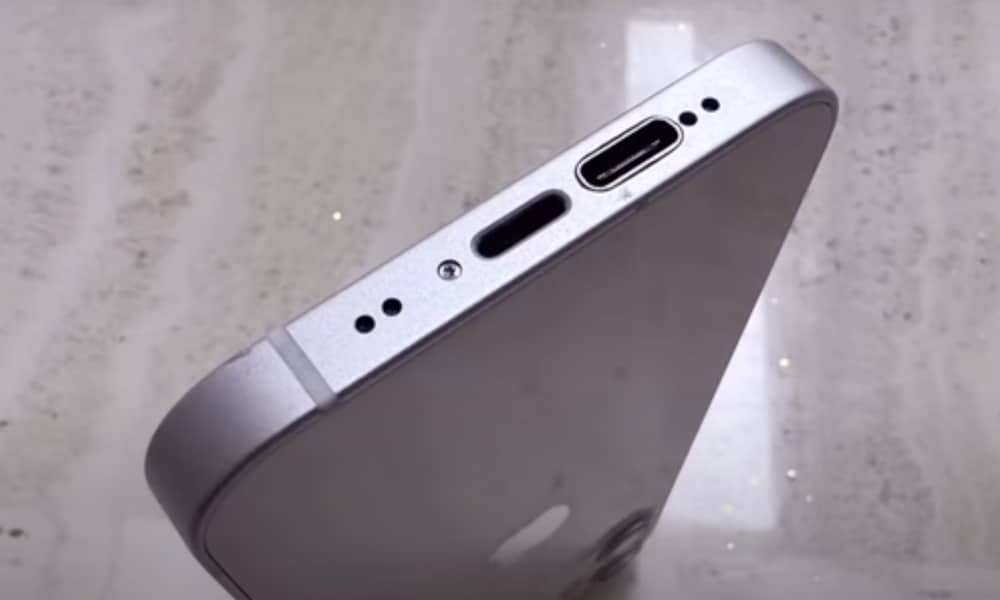Engineer Shows How the iPhone 15 Could Keep the Lightning Port

Toggle Dark Mode
It’s pretty much a given at this point that this year’s iPhone 15 will herald the much-anticipated switch from Lightning to USB-C, but one imaginative engineer has decided to create an example of how Apple could try to straddle both worlds — adding a USB-C port in addition to the Lightning port.
In a video shared on YouTube, a modder named Hyphaistos3672 disassembled an iPhone 12 mini to remove one of the speakers and create space for an additional USB-C port. They then modified the speaker to fit it back into the leftover space and reassembled the device into a working iPhone.
We’ve seen modders swap out the Lightning port for USB-C, but this is a much more interesting project, as a fully functional USB-C port was added alongside a working Lightning port.
However, despite Apple’s fixation on its proprietary Lightning port, it’s unlikely that Apple would entertain the notion of such an awkward arrangement. However, the video proves it can be done — and on an iPhone 12 mini, no less. This means it would be trivial for Apple to incorporate a design like this into its larger 6.1-inch and 6.7-inch iPhone models.
Forcing Apple’s Hand
While there’s every reason to believe that Apple plans to go all-in on USB-C over the next year, it’s hard to say whether the company would have done so by choice. After all, Apple has a long and satisfying relationship with its proprietary Lightning port, where it can collect licensing fees and control the types of accessories used with the iPhone.
Still, Apple acted pragmatically to adopt USB-C on the iPad Pro four years ago, conceding that professional tablet users had a broader need for accessory compatibility than the Lightning port would ever be able to offer. While iPhone users don’t have the same requirements, the European Union (EU) has made it clear that there should be one charging port to rule them all, and the U.S. could soon follow suit.
Apple doesn’t have much choice, and the EU is being much more forceful in its stance this time than it was ten years ago when Apple was able to wiggle out of the EU’s rules by offering a $19 Lightning to Micro USB adapter.
In short, the iPhone needs to offer a physical USB-C port for charging, not an adapter, since that would defeat the purpose of the EU legislation, which is primarily aimed at reducing electronic waste from unnecessary accessories.
Apple’s Next Move?
Unfortunately, the letter of the law only concerns ports used for charging. The EU says nothing about ports used for other things like data transfer, video and audio output, or connecting non-charging accessories. This means that Apple could theoretically do exactly what Hyphaistos3672 did by adding an extra port, and it wouldn’t even have to go as far; the new USB-C port could be there exclusively for charging, with the Lightning port still required for every other type of accessory.
Such a move would be seen as Apple tacitly protesting the decision by European regulators by doing the bare minimum to comply with the law. Thankfully, Apple isn’t usually the type of company that makes critical design decisions just to be snarky. From everything we’ve seen over the past few years, the company has been moving in the direction of reducing the ports on the iPhone. Adding an extra port would be a step in the wrong direction.
In fact, many analysts believe Apple’s longer-term game is an iPhone with no ports at all. Folks with some insight into Apple’s plans have been speculating on this for over three years, and many believed Apple would use it to avoid the USB-C transition entirely.
To be fair, it’s not that far-fetched of an idea. The EU rules don’t say that devices are required to have a USB-C port — merely that if a wired charging port exists, it must use the USB-C standard. Eliminating all charging ports in favor of MagSafe would sidestep the EU rules. Further, MagSafe is capable of doing much more than charging, so it could replace the Lightning port as well.
However, the problem is that the world still isn’t ready for a fully wireless iPhone. Wired charging is still much faster than even Apple’s 15W MagSafesince wireless charging is inherently inefficient, and some costly accessories, like CarPlay systems, still overwhelmingly use a wired connection. Wireless CarPlay is becoming more popular, but it’s still limited to higher-end vehicles since it requires an onboard Wi-Fi system. Plus, people don’t buy new cars nearly as often as they buy new iPhones.
Needless to say, even if Apple is fully prepared to build a port-free iPhone, it will have to wait for the market to catch up before it could actually get away with releasing one. In the meantime, it has no choice but to adopt USB-C, but we’re hoping that Apple’s desire to reduce the number of ports on the iPhone is stronger than its attachment to the Lightning port.
[The information provided in this article has NOT been confirmed by Apple and may be speculation. Provided details may not be factual. Take all rumors, tech or otherwise, with a grain of salt.]









